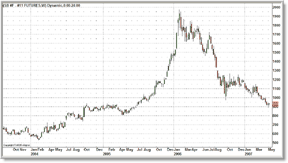Sugar: Beyond The Bear Market
by John Rose
On May 9, 2006, the New York Board of Trade sponsored its first sugar convention in New York City. The event was well attended, and many of the major players in the sugar industry were in attendance. Needless to say, the bullish tone of the event marked a top in the sugar market, and futures have retraced over 50% since then.
One of the event's key speakers was Brazil's Eduardo Pereira De Carvalho, the head of the Union of Sugarcane Agroindustry. The Brazilian stance regarding sugar has changed considerably since the government adopted an ethanol strategy. At this time, Brazil views sugar as an energy source first and a food source second. Keep in mind that Brazil was viewed with amusement when it began its ethanol program.
Back then, oil was trading in the low teens and gasoline was abundant and cheap. The courage and foresight Brazil demonstrated is beginning to show real benefits. You can bet the Brazilian government will be pushing its long-standing ethanol program worldwide, as any pioneer in an industry should. The result of this ethanol push can only come at the expense of white sugar.
De Carvalho stated that "the world cannot rely on Brazil to supply any sugar shortages." The fact is that Brazil is running at capacity in regards to refining white sugar. At the time of the convention, Brazil was turning 50% of its cane crop to sugar and the remainder to ethanol. There is excess capacity for ethanol production, but sugar production is running at 100%. In 2003 there were 100,000 vehicles in Brazil running on ethanol. In 2006 there were 900,000 ethanol-powered vehicles. The country may likely turn more sugar into ethanol if demand spikes, which would further deplete the supply of refined sugar.
IN THE SUMMER TIME
As I write this, summer driving season in the US has begun and we are facing record gasoline prices. Last year, we managed to avoid any major hurricanes and other supply disruptions. Do you think this is likely to happen two years in a row? The smallest of disruptions to the oil supply will have monumental consequences to the energy markets. The sugar market had been strongly correlated to the oil market for some time, but has recently decoupled from that relationship. I do not foresee this correlation being lost for much longer.
The Brazilians are in a unique position. Any rise in energy prices allows them to convert excess cane to ethanol, which depletes the sugar supply, thereby boosting prices of white sugar. That's a nice situation to be in when you can win on two fronts: any rise in ethanol production boosts the price of your sugar stocks. What had at one point looked like folly is now looking like genius. I can't imagine a government not exploiting this scenario and showing the world that their vision and foresight has and will continue to pay large dividends.

FIGURE 1: SUGAR #11. Here you see the weekly continuation chart of sugar futures.The recent explosion in corn prices has been interesting. I doubt that corn, which is eight times less efficient than sugar, will be the savior of the ethanol industry. The fact is that we rely on corn in too many areas of food production to make it a pure energy source. The inflationary implications of a large corn allocation to ethanol would likely outweigh any gains made through lower-cost energy.
President George Bush's recent trip to Brazil was also telling. He claims there won't be any repeal of the ethanol tax that the US currently levies at Brazil until 2008 at the earliest. Then why does the energy secretary call for the repeal of the same tax? Any kind of disruption and subsequent spike in gas prices will result in quick action by the Bush government. Japan has wasted no time inking deals with the Brazilians for ethanol, and the US won't want to be left behind.
Another factor supporting sugar is the end of European Union subsidies that will take an estimated five million tons offline. Couple those subsidies with a rewriting of the US farm bill that is scheduled to take place next year, and the rich subsidies our farmers receive may also be on the chopping block.
The current drop in sugar prices has been precipitous. On the other hand, the long-term fundamentals of sugar continue to look promising. Sugar currently has its second-lowest stocks-to-use ratio of the past nine years. Wait for the current corn craze to die down and you'll likely see the return of the original ethanol source.
Generally, a market that does not perform well gets ignored for some time. Sugar surely fits this bill, but traders need to watch for a return of the oil/sugar correlation as well as any kind of supply disruption. Sugar will no doubt turn interesting soon.
John Rose is the manager of Zaner Group's New York City branch office. He can be reached at 866 926-3769 or by email at jrose@zaner.com. His newsletters are found on his website at www.nyccommoditybroker.com and on the Zaner website at www.zaner.com.
Return to July 2007 Contents
Originally published in the July 2007 issue of Technical Analysis
of STOCKS & COMMODITIES magazine. All rights reserved. © Copyright
2007, Technical Analysis, Inc.